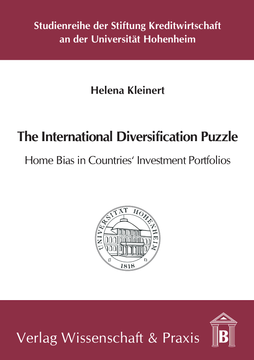The International Diversification Puzzle: Home Bias in Countries’ Investment Portfolios

BOOK
Cite BOOK
Style
Format
The International Diversification Puzzle: Home Bias in Countries’ Investment Portfolios
Studienreihe der Stiftung Kreditwirtschaft an der Universität Hohenheim, Vol. 53
(2016)
Additional Information
Book Details
Pricing
Abstract
This work analyzes determinants of portfolio decisions in the context of cross-country diversification, which cause significant overweighting of the respective domestic market. By amending traditional determinants with cross-cultural variables, this work enhances current insights on the home bias phenomena.In addition, the study sheds light on the capital market anomaly in the context of consumption risk and documents that the increasing importance of foreign positions in international investment portfolios improves international consumption risk sharing among economies.
Table of Contents
| Section Title | Page | Action | Price |
|---|---|---|---|
| Preface | 5 | ||
| Table of Contents | 6 | ||
| List of Figures | 8 | ||
| List of Tables | 9 | ||
| Abbreviations | 10 | ||
| Country Abbreviations | 12 | ||
| Variables and Indices | 13 | ||
| Introduction | 17 | ||
| A. Home Bias in International Investment Portfolios – A Literature Review | 21 | ||
| 1. Introduction | 21 | ||
| 2. International Diversification and Home Bias in Portfolio Allocation | 22 | ||
| 2.1 Gains from International Diversification | 22 | ||
| 2.2 Empirical Evidence of the Home Bias | 25 | ||
| 2.3 Measuring Home Bias in international portfolio allocation | 27 | ||
| 3. Calculation optimal portfolio weights | 29 | ||
| 3.1 Classical Mean-Variance Portfolio Model | 29 | ||
| 3.2 International Capital Asset Pricing Model | 30 | ||
| 3.3 Bayesian Portfolio Weights | 31 | ||
| 3.4 Gravity Model Approach | 33 | ||
| 3.5 Discussion of the optimization frameworks | 33 | ||
| 4. Potential Explanations for the Home Bias | 35 | ||
| 4.1 Institutional Perspective | 35 | ||
| 4.1.1 Overview | 35 | ||
| 4.1.2 Transaction Costs | 36 | ||
| 4.1.3 Hedging of domestic risk | 36 | ||
| 4.1.4 Information asymmetry | 38 | ||
| 4.1.5 Corporate Governance | 42 | ||
| 4.2 Behavioral Perspective | 43 | ||
| 4.2.1 Overview | 43 | ||
| 4.2.2 Relative Optimism | 44 | ||
| 4.2.3 Overconfidence and investor’s competence | 45 | ||
| 4.2.4 Herding | 46 | ||
| 4.2.5 Familiarity | 46 | ||
| 4.3 Discussion of the explanation attempts | 47 | ||
| 5. Conclusion | 48 | ||
| B. Cultural Influences on Domestic and Foreign Bias in International Asset Allocation | 51 | ||
| 1. Introduction | 51 | ||
| 2. Data and Placement in Literature | 53 | ||
| 2.1 Data | 53 | ||
| 2.2 Placement in Literature | 54 | ||
| 3. Calculation of the dependent variables | 56 | ||
| 4. Explanatory Variables and Regression Framework | 59 | ||
| 4.1 Explanatory Variables | 59 | ||
| 4.2 Regression Framework | 67 | ||
| 5. Empirical Results | 71 | ||
| 5.1 Results for the Domestic Bias | 71 | ||
| 5.2 Results for the Foreign Bias | 76 | ||
| 5.3 Robustness Test | 81 | ||
| 5.3.1 Additional Country Controls | 81 | ||
| 5.3.2 Income Analysis | 83 | ||
| 5.3.3 Geographic Analysis | 91 | ||
| 5.3.4 Financial Crisis | 92 | ||
| 6. Conclusion | 96 | ||
| C. Is increasing Financial Integration related to improved International Risk Sharing? | 97 | ||
| 1. Introduction | 97 | ||
| 2. Data | 99 | ||
| 3. Theoretical Background and Placement and Literature | 101 | ||
| 3.1 International Portfolio Holdings and the Equity Home Bias | 101 | ||
| 3.2 International Risk Sharing | 104 | ||
| 3.2.1 Theory | 104 | ||
| 3.2.2 Measuring International Risk Sharing and empirical evidence | 107 | ||
| 4. Patterns of Risk Sharing and International Asset Positions | 110 | ||
| 4.1 Channels of Risk Sharing | 110 | ||
| 4.2 The Increase in International Risk Sharing and the growth in Gross International Asset Positions | 113 | ||
| 4.2.1 International financial integration proxied by the Equity Home Bias | 113 | ||
| 4.2.2 International Financial Integration proxied by Foreign Equity Holdings to GDP | 115 | ||
| 5. Conclusion | 118 | ||
| Summary | 121 | ||
| References | 124 |
